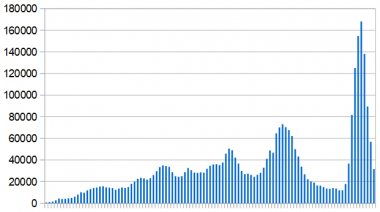No people in the world manifest such enthusiastic admiration for literary expression and are so moved by the word, spoken or written, as the Arabs. Modern audiences in Baghdad, Damascus and Cairo can be stirred to the highest degree by the recital of poems, only vaguely comprehended, and by the delivery of orations in the classical tongue, though it be only partially understood. The rhythm, the rhyme, the music, produce on them the effect of what they call "lawful magic" (sihr halal). –Philip K Hitti, History of the Arabs
The Mu'allaqat
The Muʻallaqāt are a group of seven long Arabic poems from the pre-Islamic period. According to tradition they were hung on the walls of the Kaaba in Mecca.
The Seven Hanging Odes of Mecca
Newlines magazine, May 2021
Introduction to Arabic poetry (adab.com)
Arabic-language poets
A historical list with links to biographical notes (Wikipedia)
Metre
THE METRES normally used in Arabic poetry were first codified in the 8th century by al-Khalil bin Ahmad and have changed little since.
Metre (wazn) is based on the length of syllables rather than stress. A short syllable is a consonant followed by a short vowel. A long syllable is a vowelled letter followed by either an unvowelled consonant or a long vowel. A nunation sign at the end of a word also makes the final syllable long.
In Arabic poetry each line (bayt; abyat) is divided into two halves (shatr; shatrayn).
Below are metres commonly found in Arabic poetry, showing long (—) and short (^) syllables. They represent pairs of half-lines and should be read from left to right. The patterns are not rigidly followed: two short syllables may be substituted for a long one, etc.
Tawil:
^ — — | ^ — — | ^ — — | ^ — — |
^ — — | ^ — — | ^ — — | ^ — — |
Kamil:
^ ^ — ^ — | ^ ^ — ^ — | ^ ^ — ^ — |
^ ^ — ^ — | ^ ^ — ^ — | ^ ^ — ^ — |
Wafir:
^ — ^ ^ — | ^ — ^ ^ — | ^ — — |
^ — ^ ^ — | ^ — ^ ^ — | ^ — — |
Rajaz (common in didactic poems):
— — ^ — | — — ^ — | — — ^ — |
— — ^ — | — — ^ — | — — ^ — |
Hazaj (used in Rubayyat of Omar Khayyam):
^ — — — | ^ — — — |
^ — — — | ^ — — — |
Basit:
— — ^ — | — ^ — | — — ^ — | — ^ — |
— — ^ — | — ^ — | — — ^ — | — ^ — |
Khafif:
— ^ — — | — — ^ — | — ^ — — |
— ^ — — | — — ^ — | — ^ — — |
Sari':
— — ^ — | — — ^ — | — ^ — |
— — ^ — | — — ^ — | — ^ —|
Rhyme
RHYME (qafiya) is basically determined by the last consonant of a word. In rhyme-words nunation is dropped, as (sometimes) is the final vowel. Where the final vowel is fatha (short "a"), it must be used consistently each time the rhyme occurs - though kasra (short "i") and damma (short "u") and interchangeable.
If a long vowel precedes the last syllable of a rhyme-word, it also becomes part of the rhyme. Similarly, ya (long "i") and waw (long "u") are interchangeable but alif (used as a long "a") is not.
Because short vowels are generally considered long when they occur at the end of a line, the vowels which appear short in their written form also rhyme with their corresponding long vowels - it's the pronunciation, not the writing, that counts.
In older poetry - especially the ode (qasidah) - a single rhyme was used, often continuing for 100 lines or more. Later, varied rhyme schemes were introduced, for example, where the two halves of a line rhyme with each other. Highly complex patterns have developed, such as: 1, 1, 1, 1, 1, 2, 2, 2, 2, 1, 3, 3, 3, 3, 1, 4, 4, 4, 4, 1…
Classical Arabic poetry
Princeton Online Arabic Poetry
Arabic text of classical poems with English translation, plus audio recitation. Featuring:
Imru'l-Qays (died c540)
Yazid bin Mu'awiya (died 683)
Rabi'a al-'Adawiyya (died c752)
Abu Nuwas (died 814)
al-Mutanabbi (915-965)
Classical Arabic poetry
English translations of poems by Imru-l-Quais, Antarah, Zuhair, al-Mutanabbi, Amr ibn Kulthum, Omar Al-Khayyam and al-Busairi (adab.com)
Specimens of Arabian Poetry
Online reproduction of Joseph Carlyle's book, published in 1795, discussing Arabic poetry "from the earliest time to the extinction of the Khaliphat, with some account of the authors" and English translations of poems.
Modern Arabic poetry
Featured poets (see separate pages):
Modern Arabic poetry
A large collection of translated poetry, including works by Mahmoud Darwish, Nizar Qabbani and Adonis.
Arabic poetry
A poetry blog which includes poems in Arabic with English translation, plus YouTube clips and links to other relevant sites.
Poetry Translation Centre
Translations of work by contemporary poets writing in Arabic.



